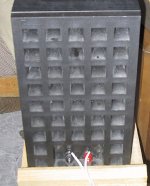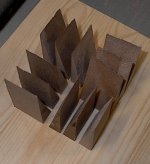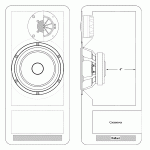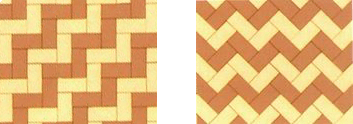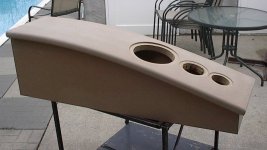planet10 said:Something i have been encouraging people to try for some time... this one worked really well...
Dave,
I'm on this one.
Worked today, so I'm tired but did find time to go out to my shop and whip up a few prisms. Not quite as deep as the ones in your pic, but an idea anyway. I could always vary the length.
I figure in about an hour I could cut enough of them to line my speaker pair. They are only 33 litres so not a big deal.
I think all of the back covered plus most of the sides and bottom. Front baffle is curved so I'll leave that blank, along with the top.
Would take quite a while to glue them all in.
These are about 2 inches long, cut from 5/8 MDF.
Attachments
John I have been following this thread with interest.
May I make a suggestion??
spray the internal faces of those wedges with a soft rubbery coating, perhaps the flocking paint that is used on foam acoustic foam panels or may be just ordinary bitumen and cellulose fibre anti-resonance paint that car detailers use to reduce noise in auto doors.
Although it does take an age to dry, it is rough to the touch ansd stays soft, and pliable.
The MDF and chipboard question? why do you use the MDF on the inside?? and have you tried carpenters PVA wood glue as well as silicon??
Ted
May I make a suggestion??
spray the internal faces of those wedges with a soft rubbery coating, perhaps the flocking paint that is used on foam acoustic foam panels or may be just ordinary bitumen and cellulose fibre anti-resonance paint that car detailers use to reduce noise in auto doors.
Although it does take an age to dry, it is rough to the touch ansd stays soft, and pliable.
The MDF and chipboard question? why do you use the MDF on the inside?? and have you tried carpenters PVA wood glue as well as silicon??
Ted
John and Dave, It will be interesting to see what results from trying this in the 33 liter box.
The enclosure I'm working with is a sealed version of Zaph's L18RNX/P 27TBFCG design. It's small. 6.5-10.5 liters. Size variation depending on actual results testing SEAS L18RNX/P drivers. (6.5 if I use Zaph's T/S parameters for modeling, 10.5 if I use SEAS published T/S parameters). I've attached a drawing of an 8.5 liter box (split the difference of the two sizes) to give an idea of the proportions. Variance in volume must be restricted to changing the depth of the box or adding the prisms.
In any case, doing this in that small enclosure is going to be a challenge. I imagine there is a correlation between the shape--height, angle of the sides--of the prism and the frequencies that will be damped, don't know details of the math though. Maybe someone who does will find this thread and chime in.
I think in a small enclosure the problem will be making the prisms high enough to be effective at critical frequencies yet still keeping them far enough away from the woofer so not to restrict the back side airflow. Might could use smaller ones or trim down the tops on the surface of the sides that are in close proximity of the woofer. I think on the rear the 2" ones could be OK.
The enclosure I'm working with is a sealed version of Zaph's L18RNX/P 27TBFCG design. It's small. 6.5-10.5 liters. Size variation depending on actual results testing SEAS L18RNX/P drivers. (6.5 if I use Zaph's T/S parameters for modeling, 10.5 if I use SEAS published T/S parameters). I've attached a drawing of an 8.5 liter box (split the difference of the two sizes) to give an idea of the proportions. Variance in volume must be restricted to changing the depth of the box or adding the prisms.
In any case, doing this in that small enclosure is going to be a challenge. I imagine there is a correlation between the shape--height, angle of the sides--of the prism and the frequencies that will be damped, don't know details of the math though. Maybe someone who does will find this thread and chime in.
I think in a small enclosure the problem will be making the prisms high enough to be effective at critical frequencies yet still keeping them far enough away from the woofer so not to restrict the back side airflow. Might could use smaller ones or trim down the tops on the surface of the sides that are in close proximity of the woofer. I think on the rear the 2" ones could be OK.
Attachments
I had one of that B&W before, I was a noob that time and just trying to find speaker that sound's pretty good, so I auditioned some with my friends and choose that one, my first "hi-fi" speaker. I sold it (DUH)
turns out later that it is listed in stereophile class D listing.
I sold it because I thought I didn't have enough bass.
yes it sounds nice.
Hartono
turns out later that it is listed in stereophile class D listing.
I sold it because I thought I didn't have enough bass.
yes it sounds nice.
Hartono
Moondog55 said:
The MDF and chipboard question? why do you use the MDF on the inside?? and have you tried carpenters PVA wood glue as well as silicon??
Hi Ted,
The boxes that I will try this on were built with the idea of using the constrained layer damping technique. To that end, the inner box was constructed from 5/8" MDF. The outer layer (1/2" veneered particleboard) is also for finished appearance.
The two layers need to be joined with a lossy material that will allow the inner layer to flex against the outer layer. Using carpenters glue would solidly adhere the two panels together, thereby creating one thick panel with no room for flexing. Using silicone gives that lossy medium between the layers.
Here's the box before painting. Front baffle extends past the side and top panels to allow for the 1/2" particleboard:
Attachments
These boxes are divided in two chambers, one for the woofer and one for the mid and tweeter.
It's going to be a test of patience to put all of those wedges inside. I only have the woofer hole and the midrange hole (my hand barely fits) to reach into. Would have been considerably easier to start construction with this in mind, as they could have been glued on each panel before assembly.
I think using the 2" or less for the midrange chamber, then longer - perhaps 3" to 4" but thicker and wider for the woofer chamber.
Maybe, as Ted suggested, spraying with a damping material has some value for keeping the prisms themselves from vibrating as they disperse the sound energy.
Recently, I test fired the speakers with the drivers installed, with no stuffing and without the CLD finished. They sounded very good (within the limits of my lowly HT receiver, right Dave?). I think this method of damping will be just the right amount.
Now, if I only had the time...
It's going to be a test of patience to put all of those wedges inside. I only have the woofer hole and the midrange hole (my hand barely fits) to reach into. Would have been considerably easier to start construction with this in mind, as they could have been glued on each panel before assembly.
I think using the 2" or less for the midrange chamber, then longer - perhaps 3" to 4" but thicker and wider for the woofer chamber.
Maybe, as Ted suggested, spraying with a damping material has some value for keeping the prisms themselves from vibrating as they disperse the sound energy.
Recently, I test fired the speakers with the drivers installed, with no stuffing and without the CLD finished. They sounded very good (within the limits of my lowly HT receiver, right Dave?). I think this method of damping will be just the right amount.
Now, if I only had the time...
Hartono said:I sold it because I thought I didn't have enough bass.
Mine were actively XOed to a pair of Peerless 8s. They were a pretty amazing speaker for store bought & $300/pr.
dave
planet10 said:
Mine were actively XOed to a pair of Peerless 8s. They were a pretty amazing speaker for store bought & $300/pr.
dave
yes, I think the enclosure damping technique, small midbass and slotted port matched very well.
Hartono
MJL21193 said:(within the limits of my lowly HT receiver, right Dave?).
You don't have anything better?
dave
John,
What is the brand and type of silicon you intended to use for bonding the constrained layer?
Ray
What is the brand and type of silicon you intended to use for bonding the constrained layer?
Ray
(within the limits of my lowly HT receiver, right Dave?)
You don't have anything better?
Hi John and Dave, you sound like a married couple😀
John, I would say you put on quite an effort here! I mean in a positive way!
I've got a question about silicone. I have been using that before but gave up as it creeping out of joints long after its supposed to have dried. This was a problem particular when using paint on MDF. And above all, silicone and lacquer/paint are like republicans and democrates🙂
Cheers!
Ray,
I like your signature line as I think along those lines also, but isn't it: "Illegitimi non carborundum"?
Or is that deliberate? 😉
I like your signature line as I think along those lines also, but isn't it: "Illegitimi non carborundum"?
Or is that deliberate? 😉
Yoo All
Use contact cement to bond your materials together.Best damping ever.Contact cement is realy neoprene rubber.Take two pieces of scrap and bond together with regular wood glue.Now do the same using contact cement.Drop on a solid surface.Gone is the ringing with the contact cement.
Cheers
The Gerry man
Use contact cement to bond your materials together.Best damping ever.Contact cement is realy neoprene rubber.Take two pieces of scrap and bond together with regular wood glue.Now do the same using contact cement.Drop on a solid surface.Gone is the ringing with the contact cement.
Cheers
The Gerry man
Cal,
Either way is OK since both phrases are pseudo-Latin. Illegitimis is the dative plural of Illegitimus. I selected the singular since much of the time there seems to be one b*st*rd leading the attempt to "grind you/me down"?!
Ray
Sorry, I am trying to make the reply unoffensive to the censors and members.
Either way is OK since both phrases are pseudo-Latin. Illegitimis is the dative plural of Illegitimus. I selected the singular since much of the time there seems to be one b*st*rd leading the attempt to "grind you/me down"?!
Ray
Sorry, I am trying to make the reply unoffensive to the censors and members.
planet10 said:
You don't have anything better?
Dave,
No, I don't have anything better than this receiver. I have an old (I mean ancient) Pioneer SA-6800 integrated amp that this one (Yamaha HTR-5760) replaced. The Pioneer in out in my workshop.
I have no claims to audiophiledumb. 😉
This being a DIY audio site, I can say that I am striving to make up for any of the Yamaha's deficiencies by building the previously mentioned speakers as full active, with filters and amps of my own devising.
Whether I get results that are better than what the Yamaha (they have been building amps a lot longer than I have) will give me, that's unknown. But one thing is for sure, I'm having fun doing it.
- Home
- Design & Build
- Construction Tips
- Discussion on what materials to build speakers out of

